January 29, 2016
Using the Circulation of Local Money to Recover the Economy and Population (Part 2): Research Shows the Benefits of 'Taking Back' Rural Revenues
Keywords: Civil Society / Local Issues Money Newsletter Steady-State Economy
JFS Newsletter No.161 (January 2016)
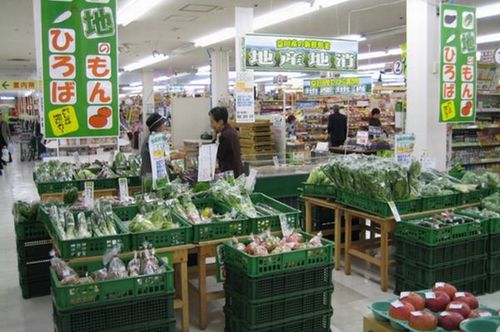
Copyright Shimane Prefectural Mountainous Region Research Center All Rights Reserved.
In the last JFS Newsletter, the December 2015 issue, we introduced the 1% Rural Recovery Strategy, a plan to take back the local economies and populations of rural areas by 1% annually, based on a lecture given by Dr. Ko Fujiyama, chief of the regional research group of the Shimane Prefectural Mountainous Region Research Center, on October 26, 2015. This issue features the second part of Dr. Fujiyama's lecture, which focuses on just how much income can be recovered by encouraging the circulation of money locally. The information reflects research done in Japan, but we believe the message is universal.
Using the Circulation of Local Money to Recover the Economy and Population (Part 1): Featuring the 1% Rural Recovery Strategy and the 'Local Multiplier 3' Effect
http://www.japanfs.org/en/news/archives/news_id035436.html
Regional Resource Use Increases Local Income
When regional resources are used locally, how much is local income expected to grow? Let's look at some estimates in different settings calculated using the Local Multiplier 3 (LM3) scheme, which is based on how much money is spent locally in the first three rounds of transactions.
Taking the example of a supermarket where most people typically shop for groceries, the current amount of local product procurement constitutes only about 5% of total sales. We project that a supermarket selling 10 billion yen (U.S.$83.3 million) worth of goods, by raising its local procurement ratio from 5% to 20%, would boost local incomes consisting of revenue of the supermarket and employees' salary of local suppliers from the current 3.25 billion yen (about $27.1 million) to 4.0 billion yen (about $33.3 million).
The promotion of efforts to procure energy resources locally also could make a big difference. For example, if heating and hot-water supply is provided using biomass resources from the area, including firewood, it positively impacts the local timber industry, and regional income could increase more than fivefold.
Let's take an example of bread, a food consumed daily. If local shops are only selling bread baked in large factories outside the area, then the local area will not gain much money. But if local bakeries bake their own bread using local wheat flour or rice flour, then more than half of the selling price is projected to remain in the area as regional income.
Another example is the home building industry. Even in rural areas, people often use major construction companies that operate nationwide these days. The regional income, however, does not increase much when local companies simply work as subcontractors working under companies based in other cities and build houses using materials produced outside of the region. In contrast, the regional income expands when local builders build houses using local materials. This also contributes to local culture and regional environment.
The Data Support the Significant Potential of Returning Income to Local Areas
Now, I would like to tell you about our analysis of the actual data collected from some areas to see the potential in recovering regional income. According to household expenditure surveys conducted by the Shimane Prefectural Mountainous Region Research Center, the annual expenditure for bread per household is 30,000 yen (about $250). In the case of an area with 300 households, the total demand for bread amounts to as much as 10 million yen (about $83,000). If people buy bread from market outside of the area, regional income does not increase, as explained in the previous examples. On the other hand, if people buy locally-made bread from local bakeries, the sales would be enough to cover the profits of one bakery, allowing some new residents to settle in the area.
How about fuel expenses such as kerosene and gas? Since the annual expenditure per household for fuel is 110,000 yen (about $917), total demand exceeds 100 million yen (about $0.83 million) in an area with 1,000 households. By compiling household expenditure surveys in this way, we are able to see the potential of recovering income and then increasing the number of people who can settle down in the area.
Also, research on economic circulation in a local city with a population of 70,000 shows that the amount of money spent buying things from outside the city area was equal to the total income of its residents. Looking carefully, we can see that their economic circulation relies heavily on external sources. Despite such a situation, how can the local economy still function in this area? It is because the city receives a money injection amounting to 100 billion yen (about $833 million) in the form of local tax grants, subsidies, and pensions from the nation's budget.
This is not a sustainable economy for either the local city or the whole country. But let's look at the situation upside down. How about reallocating 1% of total purchases from outside of the area to the local production of raw materials? The reallocated 1% can generate an income increase of 1% in the area. This is the key to the strategy of 1% growth in income recovery.
A household expenditure survey in a semi-mountainous area showed that about half of food expenditures were spent outside of the area, especially for eating-out (restaurants, etc.). The average annual food expenditures per household were about 550,000 yen (about $4,580), of which only 1.4% was spent on locally produced food. This is a truly disappointing result from the viewpoint of the local economy as well as local food culture. Furthermore, supermarkets, convenience stores, hotels, and welfare facilities in the area procured their food mostly from non-local shops, except for buying local products at farm stands.
Small Local Hubs Could Support Rural Community Life
Based on these data, I introduce here a specific simulation study on income recovery in a semi-mountainous area with a population of 4,000. In the simulation, if 50% of all items of food and fuel were purchased at local shops, about 16 million yen (about $133,330) of income was newly created, equal to an amount that would support about five households.
Next let's look at another case in which the ratio of products produced locally is increased to 30%, while keeping the ratio of local purchases unchanged. In this case, the income increase is considerably large, amounting to more than 60 million yen ($500,000), which can provide a living for 21 households. When thinking about items to sell at shops, new businesses such as bakery and sweets shops could be launched. Increasing the local circulation ratio of local products makes it possible to secure actual income to support people that settle down in rural areas.
I think we have to create a social system to not only recover the economy and population of regional areas, but also realize more sustainable communities. According to the national government's grand design compiled in 2014 and the comprehensive strategy for regional revitalization revised in 2015, an initiative is planned to support rural life with the creation of small local hubs in semi-mountainous areas where communities are scattered.
The point of our idea here is to establish small hubs as collective workstations and transportation networks to support the livelihoods of neighboring communities, instead of aiming to bring people to central areas from dispersed settlements. Once such hubs are formed, they would be good "ties" to connect and circulate local foodstuffs and fuels within the area more efficiently.
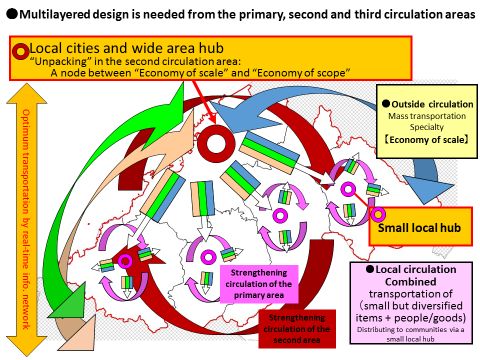
Copyright Shimane Prefectural Mountainous Region Research Center All Rights Reserved.
The Wealth of Having a Large Variety of Things in Small Quanitities
Now, let's move on to a discussion about a new way of being a society and the sense of values we would like to realize in the future. In the mountainous farming villages in large parts of Japan, I do not believe that wealth is something that can be measured quantitatively. These villages each have their own special character created from a variety of products. When we conducted research in a village with a population of 1,500, we found that the number of products grown or processed there numbered 4,508. In spite of this richness in variety, less than half of the items were actually available for sale on the market. With today's emphasis on economies of scale, many of these food items could never find their way into the market. So what can we do about this?
One good example is Kinuya Corporation that runs a chain of supermarkets in the western part of Shimane Prefecture, Kinuya is raising the percentage of local products among its entire merchandise. Local products once accounted for about 8% of total sales but this has risen to nearly 15%, because Kinuya has increased its use of local products by 1% each year.
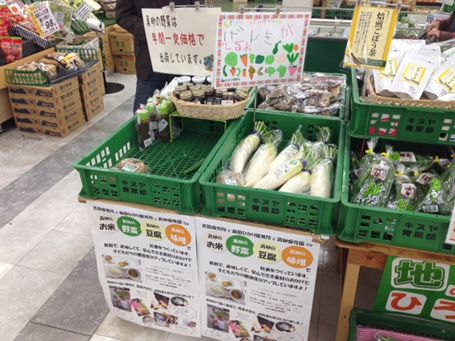
Copyright Shimane Prefectural Mountainous Region Research Center All Rights Reserved.
Any farmers and food processors can bring in their vegetables and processed foods to the supermarket to sell at a locally-produced product corner by paying a 15% commission. Some farmers have gained annual sales of over 10 million yen (about $83,300) exclusively in that section of this supermarket chain. As many as 607 farmers and food processors ship their products to all of Kinuya's supermarkets, and the total local goods Kinuya purchases now has reached 1.6 billion yen (about $13.3 million). Above all, these vegetables are fresh, inexpensive, and delicious.
Like this case, market systems can be used to circulate many locally-produced items in small quantities in mountainous areas to the nearest regions. One possible system is a street stand, which is now gaining popularity nationwide, where small trucks go directly from farms to cities nearby with vegetables loaded on the rear deck.
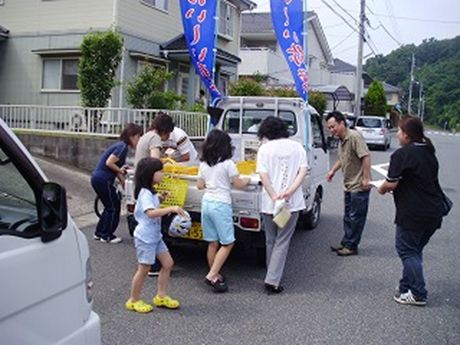
Copyright Shimane Prefectural Mountainous Region Research Center All Rights Reserved.
In the current systems of society, which put a priority on economies of scale, we have been losing the option of having choice in a variety of things in small quantities. However, this alternative approach will actually give us delicious foods, attractive products, and the potential to return economic value back to local communities.
Just as biodiversity is important in nature, the wealth in our lives needs to go back to a situation that has vast diversity of things in small quantities. To develop the whole system to form a more sustainable society, it is essential not only to have such diversity of things at the local level, but also to have transport systems to collect these things and carry them to towns and cities nearby. On that point, I believe that we should develop schemes to connect local circulation systems to larger, specialized logistical systems connected outside of local areas.
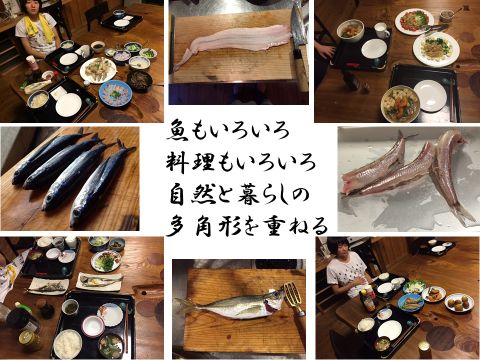
Copyright Shimane Prefectural Mountainous Region Research Center All Rights Reserved.
Edited by Naoko Niitsu and Junko Edahiro
Related
"JFS Newsletter"
- 'Good Companies in Japan' (Article No.4): 'Eightfold Satisfaction' Management for Everyone's Happiness
- "Nai-Mono-Wa-Nai": Ama Town's Concept of Sufficiency and Message to the World
- 'Yumekaze' Wind Turbine Project Connects Metro Consumers and Regional Producers: Seikatsu Club Consumers' Co-operative
- Shaping Japan's Energy toward 2050 Participating in the Round Table for Studying Energy Situations
- 'Good Companies in Japan' (Article No.3): Seeking Ways to Develop Societal Contribution along with Core Businesses


